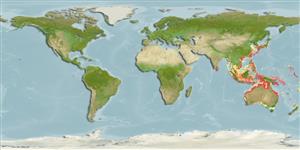Common names from other countries
Environment: milieu / climate zone / depth range / distribution range
Ökologie
seewasser demersal. Tropical
Eastern Indian Ocean to Western Pacific: Australia and Indonesia.
Size / Gewicht / Alter
Maturity: Lm ? range ? - ? cm
Max length : 45.0 cm TL Männchen/unbestimmt; (Ref. 3132); max. veröff. Gewicht: 5.0 kg (Ref. 3132)
This species is distinguished by the following characters: a single small isolated dorsal spine anteriorly; second dorsal and anal fin rays usually 13; snout long, 28.5-31.0% HL; larger specimens with interorbit narrow 7.7-12.0% HL; postorbital short, 50.7-56.4% HL; posterior portion of snout and interorbital covered with scales; upper iris lappet triangular; skinny sensory tubes from the suborbital bones and preopercle not covering the cheek region; preopercule with 2 spines, the lower slightly longer than the upper; fingerlike interopercular flap; a single exterior opening of the lateral line scales; head and body pale brown, with many small brownish spots dorsally, 4 or more dark longitudinal bands on caudal fin, and upper lobe of caudal fin lacking yellow blotch when fresh (Ref. 86914).
Found on sand bottoms (Ref. 3132). Neither anterolateral glandular groove nor venom gland is present (Ref. 57406).
Life cycle and mating behavior
Geschlechtsreife | Fortpflanzung | Ablaichen | Eier | Fecundity | Larven
Imamura, H., 2008. Synonymy of two species of the genus Platycephalus and validity of Platycephalus westraliae (Teleostei: Platycephalidae). Ichthyol. Res. 55:399-406. (Ref. 86914)
IUCN Rote Liste Status (Ref. 130435)
CITES (Ref. 128078)
Not Evaluated
Nutzung durch Menschen
Mehr Information
NamenSynonymeMetabolismusRäuberÖkotoxikologieFortpflanzungGeschlechtsreifeAblaichenFecundityEierEientwicklung
Alter/GrößeWachstumLänge-GewichtLänge-LängeLängenhäufigkeitenMorphometrieMorphologieLarvenLarven Pop.Dyn.RekrutierungDichte
ReferenzenAquakulturAquakultur ProfilZuchtlinienGenetikElectrophoresesVererbbarkeitKrankheitenVerarbeitungMass conversion
PartnerBilderStamps, Coins Misc.LauteCiguateraGeschwindigkeitSchwimmstilKiemenoberflächeOtolithsGehirngrößeSehfähigkeit
Tools
Zusatzinformationen
Download XML
Internet Quellen
Estimates based on models
Preferred temperature (Ref.
115969): 21.5 - 28.8, mean 27.7 (based on 528 cells).
Phylogenetic diversity index (Ref.
82804): PD
50 = 0.5000 [Uniqueness, from 0.5 = low to 2.0 = high].
Bayesian length-weight: a=0.00525 (0.00246 - 0.01120), b=3.04 (2.85 - 3.23), in cm Total Length, based on LWR estimates for this (Sub)family-body shape (Ref.
93245).
Trophic level (Ref.
69278): 4.4 ±0.7 se; based on diet studies.
Widerstandsfähigkeit (Ref.
120179): mittel, Verdopplung der Population dauert 1,4 - 4,4 Jahre. (Preliminary K or Fecundity.).
Fishing Vulnerability (Ref.
59153): Low to moderate vulnerability (35 of 100).
